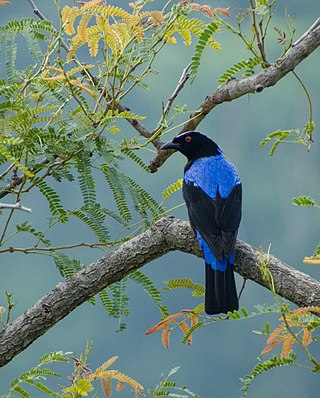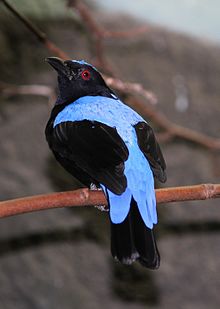
The leafbirds (Chloropseidae) are a family of small passerine bird species found in the Indian Subcontinent and Southeast Asia. They were formerly grouped with the ioras and fairy-bluebirds in the family Irenidae. As presently defined, the leafbird family is monogeneric, with all species placed in the genus Chloropsis. A large molecular phylogenetic study published in 2019 found that the family Chloropseidae is sister to the family Irenidae containing the fairy-bluebirds.

The ioras are a small family, Aegithinidae, of four passerine bird species found in south and southeast Asia. The family is composed of a single genus, Aegithina. They were formerly grouped with the leafbirds and fairy-bluebirds, in the family Irenidae.

The garden sunbird, previously known as the olive-backed sunbird, is a species of passerine bird in the family Nectariniidae that is found in the Philippines except on the Palawan island group. It was formerly considered to be conspecific with seven other species: the ornate sunbird, Palawan sunbird, Sahul sunbird, Tukangbesi sunbird, Flores Sea sunbird, South Moluccan sunbird and the Mamberamo sunbird. It is a small, brightly coloured bird with olive-green plumage on the wings and back with a bright yellow chest. It has a long downward-curved bill it uses for taking nectar and capturing insects. It is primarily nectarivorous, but will take insects and spiders, particularly when feeding chicks.

The Asian fairy-bluebird is a medium-sized, arboreal passerine bird. This fairy-bluebird is found in forests across tropical southern Asia, Indochina and the Greater Sundas. Two or three eggs are laid in a small cup nest in a tree. It was described by British ornithologist John Latham in 1790. The only other member of the genus and family is the Philippine fairy-bluebird, I. cyanogastra, which replaces the Asian fairy-bluebird in most of the Philippines. Both species are considered as sacred to the Tagalog people as they are perceived as tigmamanukan omens.

Passerida is, under the Sibley-Ahlquist taxonomy, one of two parvorders contained within the suborder Passeri. While more recent research suggests that its sister parvorder, Corvida, is not a monophyletic grouping, the Passerida as a distinct clade are widely accepted.

The Philippine leafbird is a species of bird in the family Chloropseidae. It is endemic to the Philippines. It is found in the islands of Mindanao, Leyte, Samar and Cebu. Its natural habitat is tropical moist lowland forest. It is threatened by habitat loss.

The Philippine fairy-bluebird is a species of bird in the family Irenidae. It is endemic to the Philippines being found in the islands of Luzon, Mindanao, Samar and Bohol.

The Palawan fairy-bluebird is a species of bird in the family Irenidae. It is endemic to the island of Palawan in the Philippines. Its natural habitats are tropical moist lowland forest and it is declining due to habitat destruction and deforestation.











